Analysing India's Power Shortages and Soaring Global Energy Prices
BOTTOM LINE UP FRONT
• India felt the impact of the global energy crisis in October, 2021 as coal shortages brought the country to the brink of a power crisis. The energy crisis is mainly a result of a faster than expected recovery from the COVID-19 pandemic.
• This recovery has resulted in demand for energy skyrocketing as industries try to maximise production and cover up losses incurred in 2020.
• Simultaneously, energy producers and policy makers failed to account for this surge in demand, which has led to production-side shortages and supply bottlenecks.
• This report assesses the coal supply shortage in India and provides a state-wise breakdown of power generation capacities impacted in the first half of October, 2021.
• The report shows that the states in north India, namely Punjab, Haryana, Rajasthan and Uttar Pradesh, suffered the highest number of power disruptions. However, most other states too suffered power disruptions, albeit to a lesser extent.
• Additionally, the report highlights the global and Indian price trends for natural gas and crude oil. Prices of both these commodities are trading at multi-year highs.
INDIA’S COAL SHORTAGE AND IMPACT ON POWER GENERATION
• Coal shortages in India in the start of October led to power cuts in several states. The coal shortage was attributed to the following factors:
◦ A faster than expected recovery from COVID-19 leading to a surge in demand for power (see graph below).

Source: Central Electricity Authority/Times of India
◦ Coal consumers resorting to tapping into reserve stocks rather than imports in view of high global coal prices (see graph below). The initial belief was that the high coal prices were not sustainable. However, prices have failed to correct due to factors including energy crises in different parts of the world and drop in production in key exporter countries.
Global Coal Prices
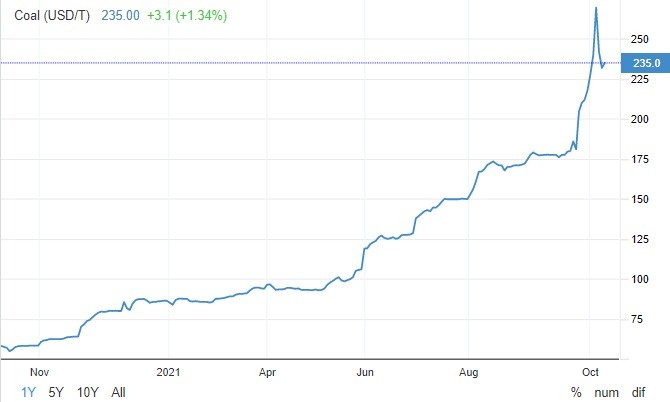
Source: Trading Economics
◦ A seasonal drop in coal production during the monsoon (July-September), when mines are forced to periodically curtail operations due to flooding; weather-related events also increase logistical bottlenecks. Additionally, the monsoon usually cools off around mid-September, but continued into the first week of October this year.
• The above factors resulted in domestic coal producers facing difficulties in meeting their supply commitments amid high demand and a jump in coal prices on domestic spot markets. Reports indicate that current coal prices on domestic spot markets are up to 4 times higher than pre-monsoon levels.
Dependency patterns: Power sector and coal
• ~65% of coal in India (locally produced + imported) is used for electricity generation in its 135 coal-fired power plants. Power generation from coal accounts for ~65-70% of India’s total power generation.
• India is the second largest producer, consumer and importer of coal. Imported coal has made up ~20-30% of the total coal in India in recent years. Indonesia, Australia and South Africa are the largest exporters to India.
• Coal India Limited (CIL) produces ~80% of India’s coal; the rest ~20% is produced from captive mines owned by private players. Odisha, Jharkhand and Chhattisgarh produce ~70% of India’s coal; Madhya Pradesh, Telangana and Maharashtra are other major producers.
India’s power supply shortage
• As of October 18, the Central Electricity Authority (CEA) stated that India’s coal-fired power plants have an average of ~4 days worth of coal reserve stocks. This average has stayed the same since September 29 (see graph below). The plants are ideally required to have at least 14 days worth of reserves.
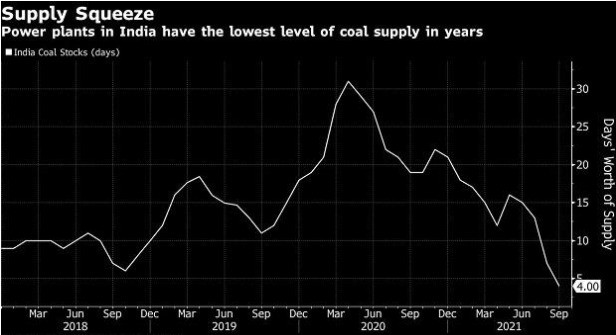
Source: Central Electricity Authority
• In the first week of October, the pan-India gap between demand and supply of power had increased by ~21 times as compared to the same period last year and ~4 times that in 2019. However, the gap has since reduced(see graph below).
Pan-India Power Shortage
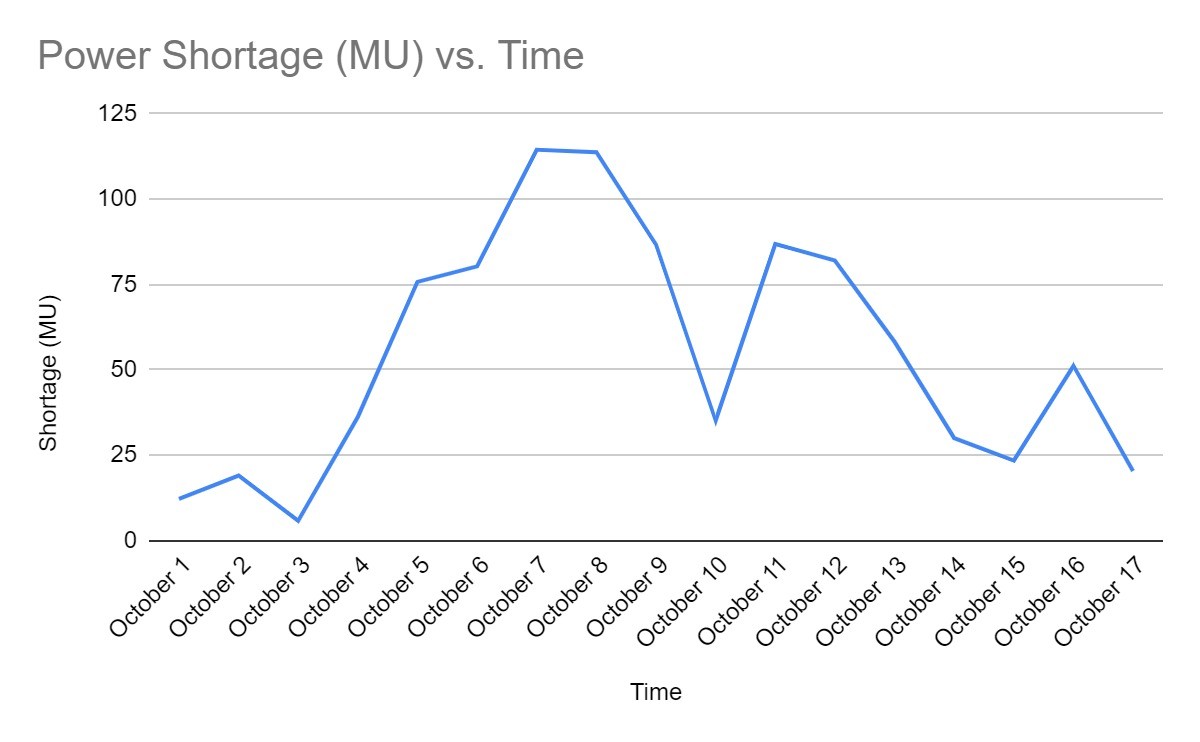
Source: Power System Operation Corporation (POSOCO); MU stands for Million Units
• Notably, October is traditionally the month with highest energy consumption due to high post-monsoon demand, hot weather and the festive season. Sources had estimated that festive days in mid-October (when demand was high) could be potential flashpoint days for the power sector.
• However, the situation appears to have improved by mid-October due to uninterrupted coal supplies from mines (which have reached record highs) and an earlier than anticipated drop in temperatures, especially in north India.
• Additionally, CIL prioritized coal supplies to the power sector. Meanwhile, the centre allowed the sale of 50% coal produced from captive mines on the open market and ordered thermal power plants to mix 10% imported coal in their stocks.
• Having said this, the low stocks at thermal power plants makes the power sector vulnerable to supply-side disruptions. Official sources have stated that the situation will be ‘touch-and-go’ for at least the next 6 months. States in north India are deemed more vulnerable to power cuts due to longer coal supply chains and lesser purchasing power of utility providers.
State-wise breakdown of power supply situation
PUNJAB
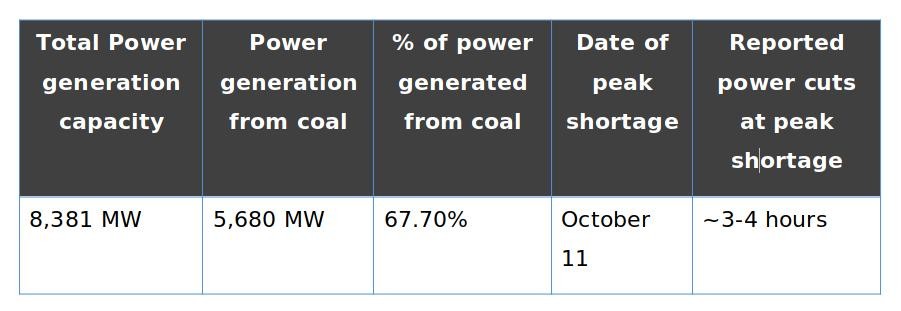
Risk Rating: High
Punjab Power Shortage
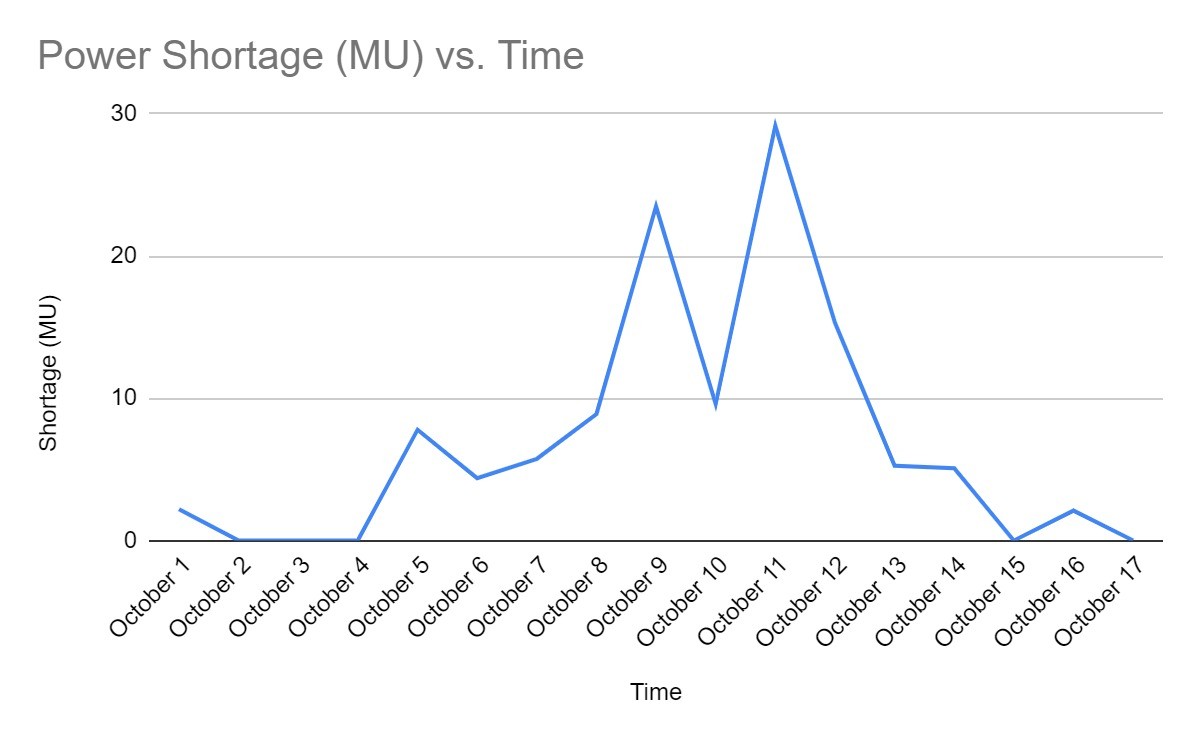
Source: Power System Operation Corporation (POSOCO)
• Punjab was one of the worst impacted states with a recorded shortage of 29.6 MU on October 11.
• Several units in Lehra Mohabbat and Talwandi Sabo plants had to be shut down due to supply shortages of coal rakes. As a result, consumers witnessed power cuts of ~ 4 hours from October 10 to October 14.
• The state power corporation struck a deal to buy 500 MW with Tata Power’s imported coal-based plant in Mundra, Gujarat from October 12 to October 19.
• However, the situation seems to have eased significantly since then. A drop in the temperature as a result of sudden rainfall has reduced daily power demand to about 6,000 MW on October 17 from a high of 9,500 MW seen in the preceding week, i.e. between October 4 and October10.
HARYANA
Risk Rating: High

Haryana Power Shortage
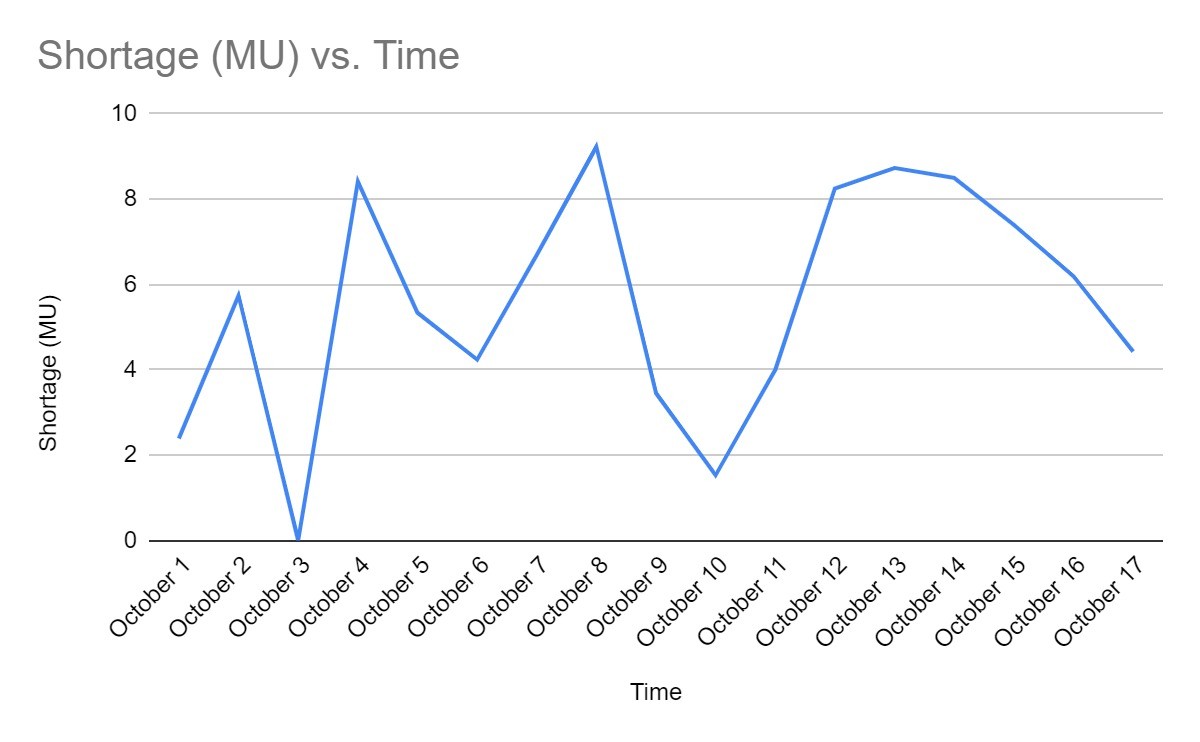
Source: Power System Operation Corporation (POSOCO)
• Reports suggest that unscheduled power cuts lasting between 3-8 hours have been recorded in some parts of the state.
• Officials have however insisted that the availability of coal has been improving and no power cuts have been imposed on consumers.
UTTAR PRADESH
Risk Rating: High

Uttar Pradesh Power Shortage
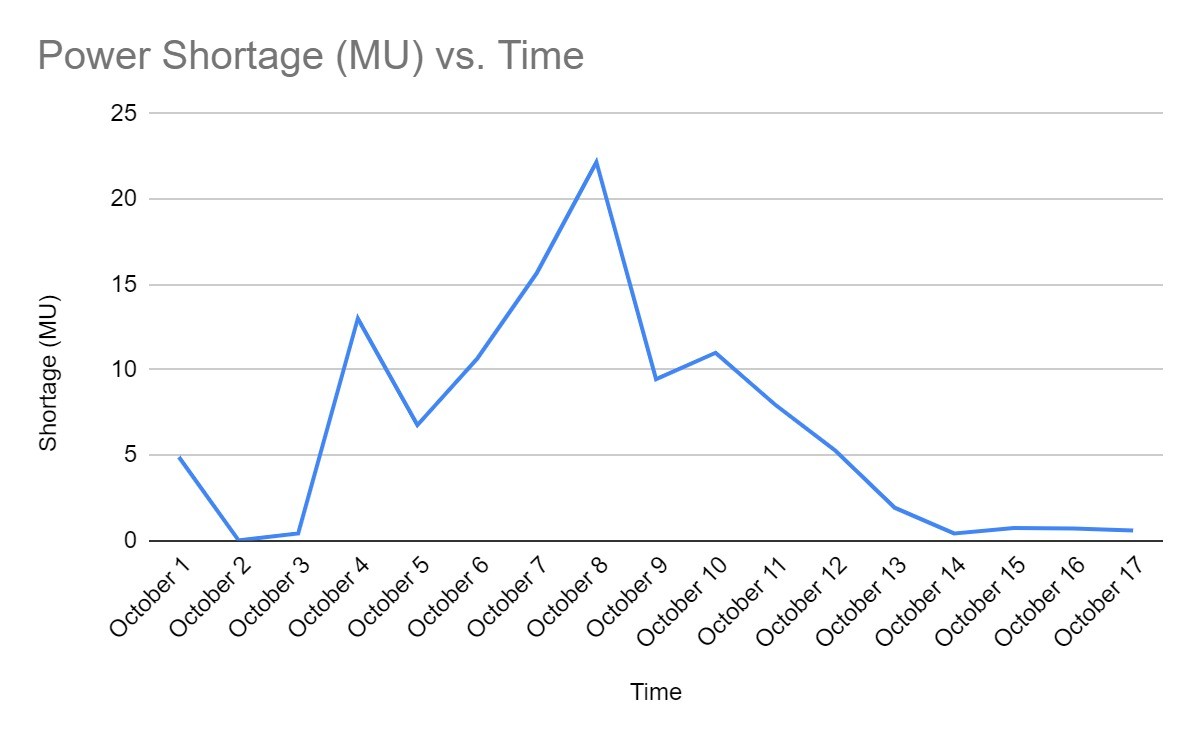
Source: Power System Operation Corporation (POSOCO)
• Power generation units have been reportedly shut down in Harduaganj, Obra, Anpara, Paricha, Tanda and Roja due to unavailability of adequate coal supplies. This led to several cities facing power cuts of up to 6 hours.
• Meanwhile, daily power demand in the state has crossed the 20,000 MW mark with a shortfall of about 5,000 MW per day.
• The Chief Minister has announced that the state government has been procuring electricity at a cost up to INR 22/unit from outside sources to ensure that there is no disruption to end consumers during the festival season.
RAJASTHAN

Risk Rating: High
Rajasthan Power Shortage
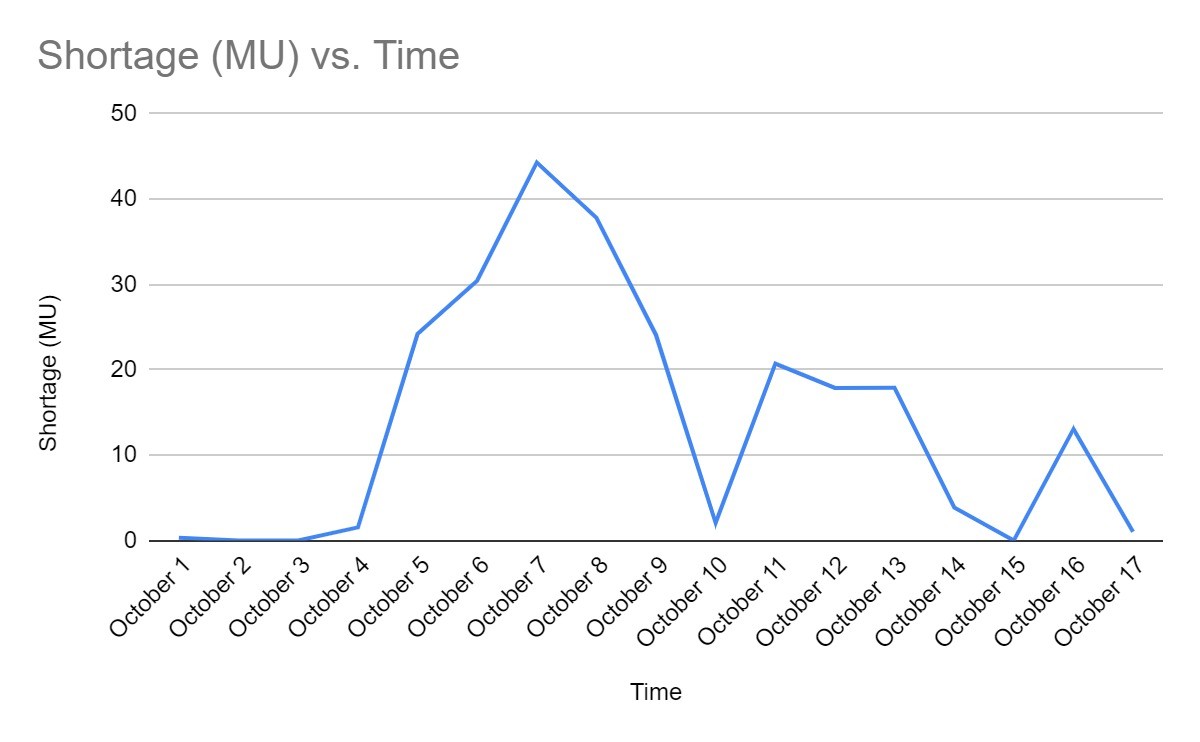
Source: Power System Operation Corporation (POSOCO)
• Undeclared power cuts of 4-5 hours in Rajasthan had begun since late-August due to shortage of funds to make payments for coal. The problem further exacerbated in October due to the decrease in supply of coal.
• 6 units in Suratgarh of 250-MW each, a unit in Kalisindh (600-MW) and another in Barmer were shut down due to coal shortage. However, from October 9-15, power production has restarted in 4 of these units.
• Due to decrease in power generation, Jaipur Discom and Ajmer Vidyut Vitran Nigam Ltd (AVVNL) had announced power cuts in various districts of Rajasthan from October 8 for ~6 hours.
• The Rajasthan government has claimed that as of October 15, there have been no power cuts in the state. This is due to resumption of 1700-MW power generation in 4 units in Rajasthan.
ASSAM

Risk Rating: Low
Assam Power Shortage

Source: Power System Operation Corporation (POSOCO)
• The state power corporation warned about possible power cuts in the state on October 11. It cited reduced power generation at its thermal plants as being the reason behind the cuts.
• However, on October 13, the state power minister assured consumers that no load shedding would take place. The state government moved to procure an additional 180 MW from the North Eastern Electric Power Corporation Limited (NEEPCO) to meet the deficit.
• Additionally, the supply of the Bongaigaon power plant was increased by 50 MW around peak demand hours.
MADHYA PRADESH
Risk Rating: Low

Madhya Pradesh Power Shortage
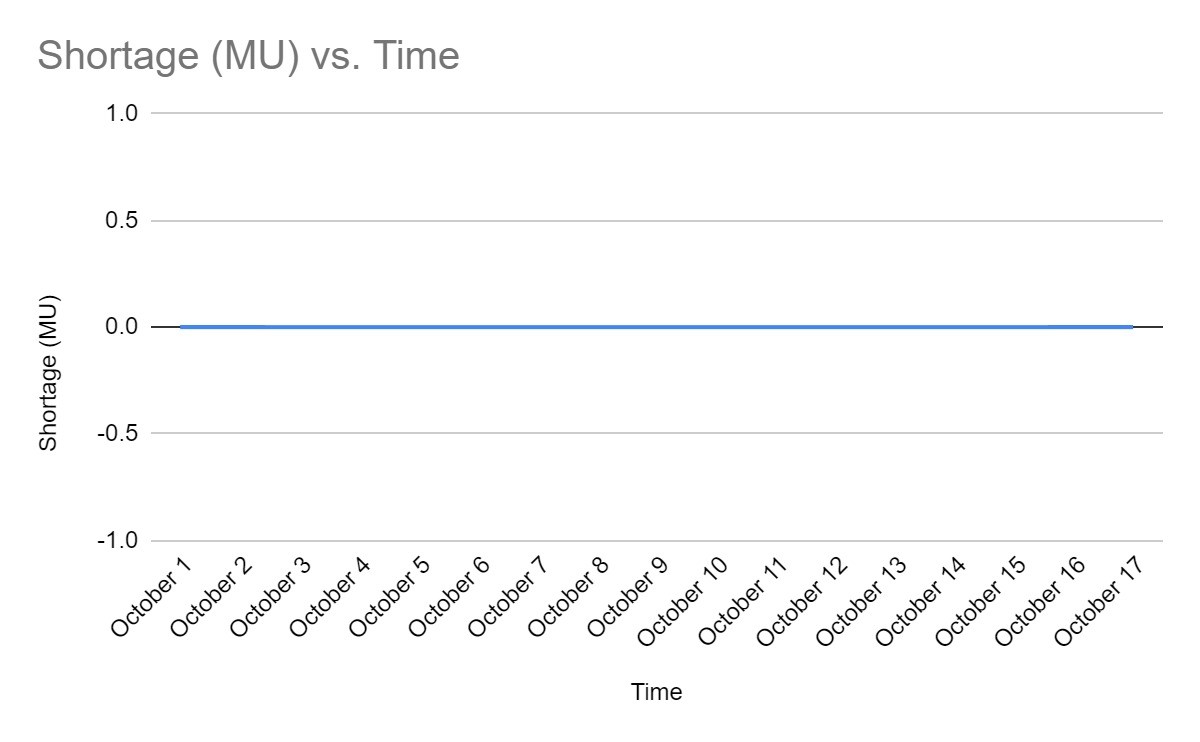
Source: Power System Operation Corporation (POSOCO)
• Shortage of coal has hit around 1,000 MW of thermal power production in the state, according to a government official.
• However, state power officials have insisted that there haven’t been any ‘declared power cuts’. This is despite the fact that Madhya Pradesh’s thermal plants have been producing power at half of their capacity due to only getting 10 rakes of coal per day.
GUJARAT
Risk Rating: Medium
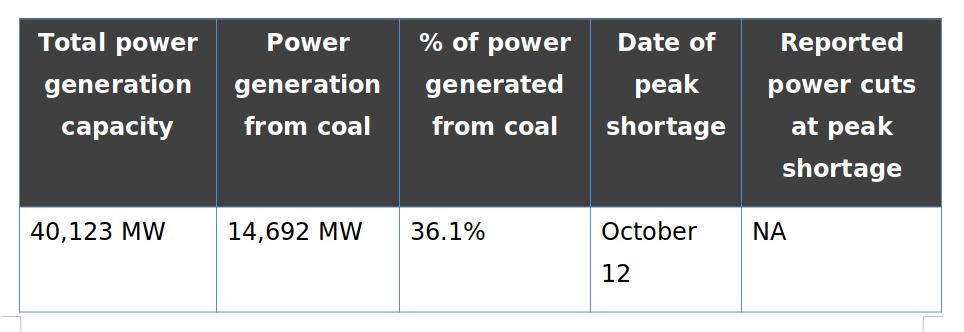
Gujarat Power Shortage

Source: Power System Operation Corporation (POSOCO)
• Coal shortage in Gujarat has led to private power producers fueled by imported coal, namely Adani Power (1,000 MW), Essar Power (1,000 MW), and Coastal Gujarat Power Ltd–a subsidiary of Tata Power (2,000 MW), temporarily shutting down thermal power generation plants.
• It was reported that to avoid power cuts, Gujarat Urja Vikas Nigam Ltd (GUVNL) is buying an estimated 4,000-5,000 MW of power at about INR 15/unit daily from power exchanges.
• This high cost burden is expected to be passed on to the consumers in future through Fuel and Power Purchase Price Adjustment (FPPPA) charges.
• Gujarat has also become the second state to purchase power from Mundra ultra mega power plant (UMPP) of Tata Power at INR 4.5/unit.
MAHARASHTRA
Risk Rating: Low

Maharashtra Power Shortage

Source: Power System Operation Corporation (POSOCO)
• Maharashtra faced shortage to its coal supply in the first week of October as a result of which about 13 power generation units were shut down till October 11. These included plants in Chandrapur, Bhusawal and Nashik. However, emergency procurement from private companies and inputs from other energy sources like hydro helped plug a shortfall of about 330 MW.
• Only 4 of Maharashtra’s 27 power generating units remained shut down as of October 15. The chairman of the state electricity board as well as the deputy chief minister have stated that the state will not face power cuts.
• They have supported their claims by citing the increased supply of coal rakes to power plants in October compared to September. Maharashtra also has the option to tap into the central government’s electricity grid during peak demand periods.
TELANGANA
Risk Rating: Medium
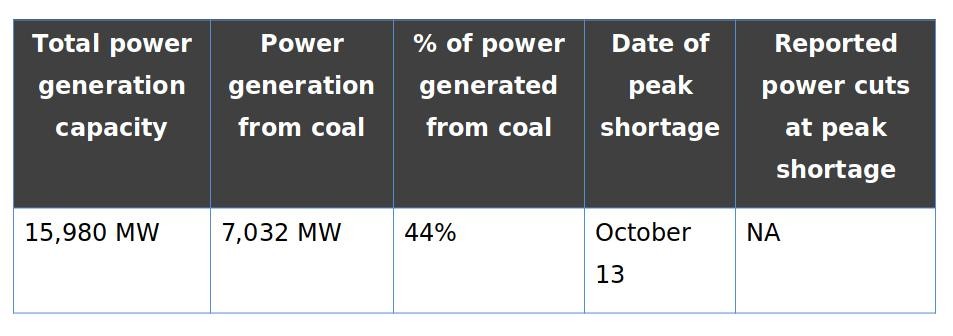
Telangana Power Shortage
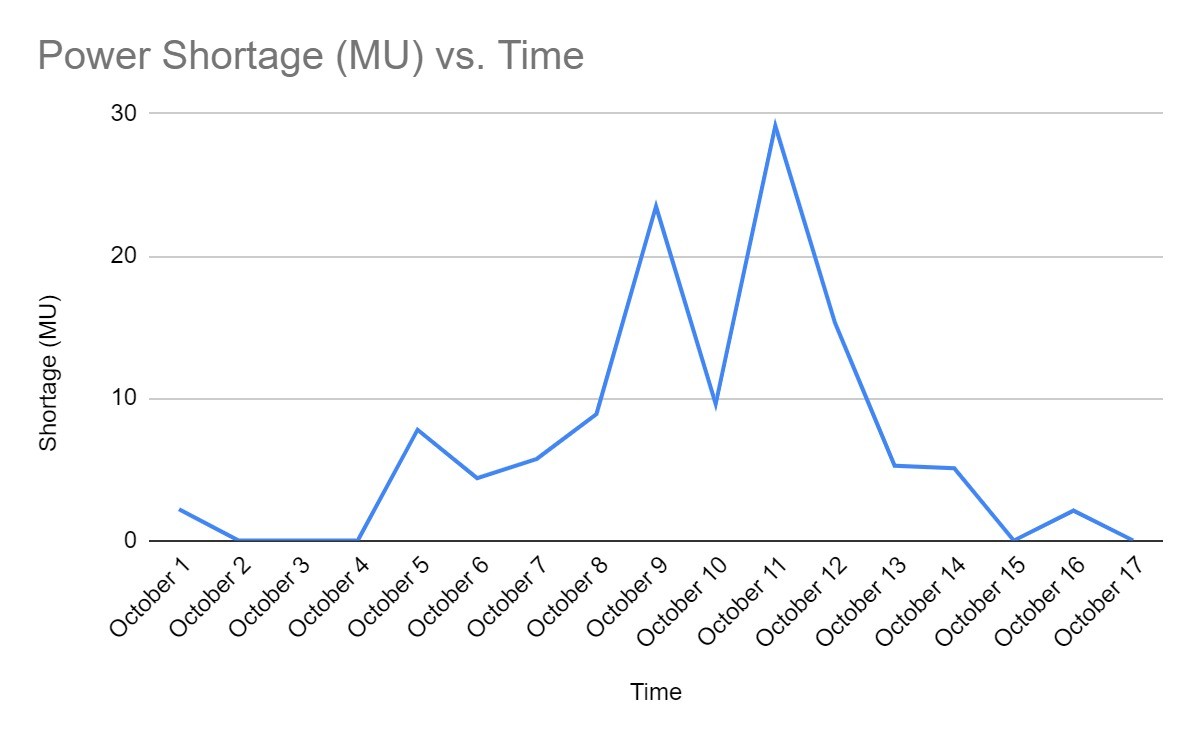
Source: Power System Operation Corporation (POSOCO)
• The Energy Minister on October 11 stated that there is no shortage of coal for power production in Telangana and assured that there will be no power cuts.
• However, reports said coal stocks at thermal power stations in Telangana were dwindling as the center has put pressure to increase coal supply to other states.
• Reports estimated that Telangana’s thermal power plants had coal stocks for 10-15 days in the second week of October, which later reduced to 5 days in the next week.
• The fall in coal stock is because thermal plants in Telangana have agreements with Singareni Collieries Company Limited (SCCL) in which the state government is the major stakeholder at 51% and the center holds 49% stake. It was noted that certain states (Andhra Pradesh, Maharashtra and Karnataka) have started claiming unused coal quotas from SCCL that were allocated for previous months.
• SCCL officials have maintained that they are committed to ensuring adequate coal supplies to power plants in Telangana.
ANDHRA PRADESH
Risk Rating: Medium

Andhra Pradesh Power Shortage
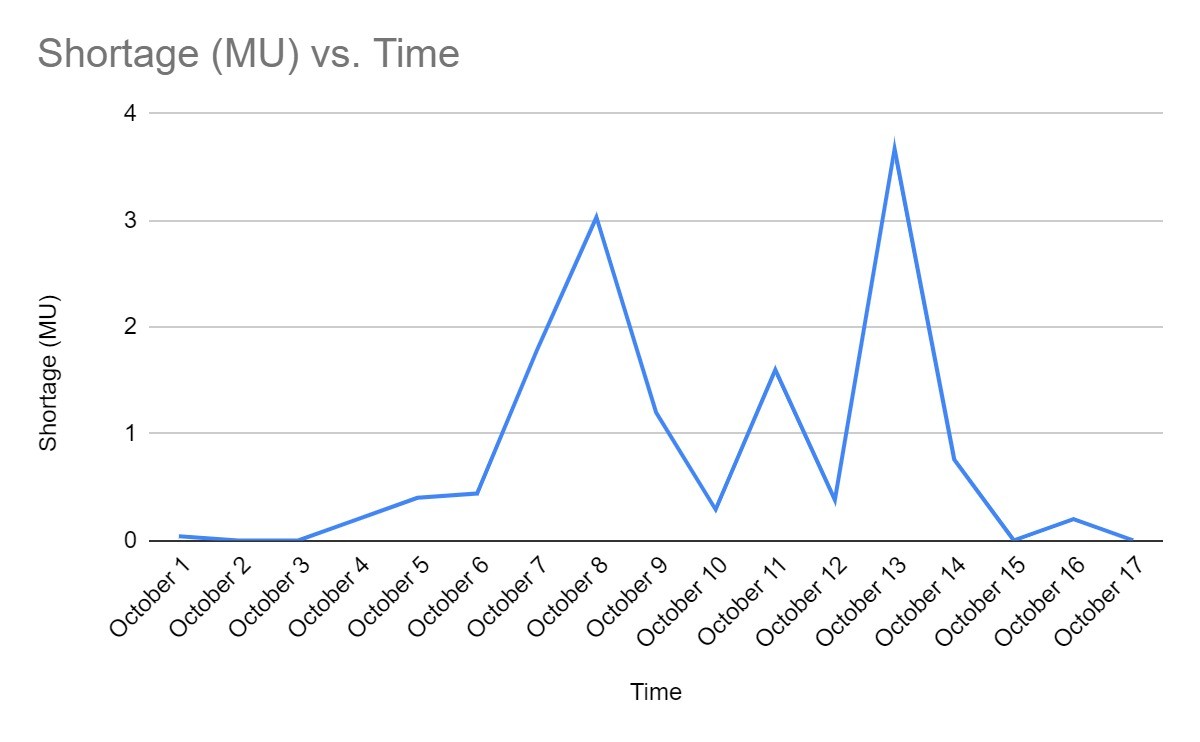
Source: Power System Operation Corporation (POSOCO)
• The power crisis reached a peak in the state around October 11 when the daily power demand jumped to about 190 MU, while supply was 145 MU. Power utilities depended on spot purchases to meet the shortfall.
• That led to bouts of unofficial power cuts in some rural areas. The government however, brushed off reports of planned power cuts after Dussehra festival on October 15.
• Lately, there have been signs of an easing of the crisis as the state power deficit has come down. Additionally, several key coal plants have restarted power generation in recent days as well.
• The state power corporation had been allocated INR 250 crores to buy coal rakes from all possible sources.
KARNATAKA
Risk Rating: Medium

Karnataka Power Shortages
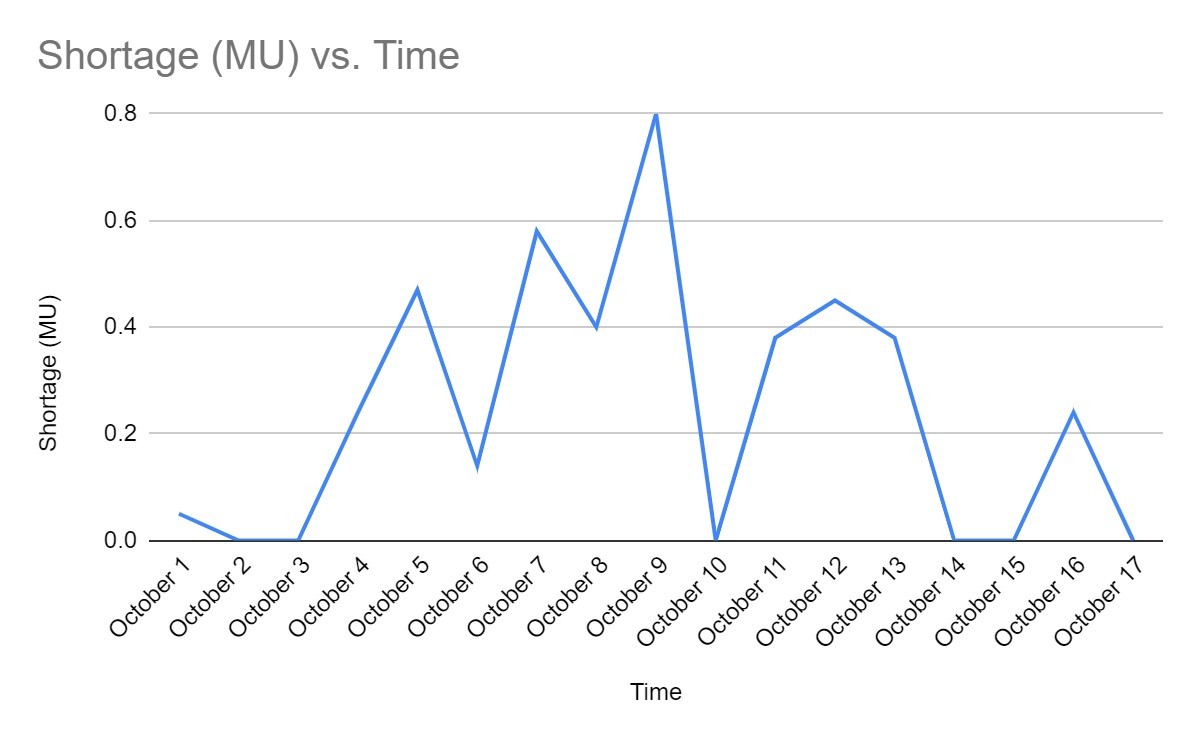
Source: Power System Operation Corporation (POSOCO)
• The Bengaluru administration had imposed power cuts in several areas of the city in recent days due to shortage of power supply.
• However, heavy rains in September have reduced the demand for power for irrigation purposes in the state. Also, Karnataka’s solar power plants have helped shoulder more than 50% of the power demand during the day.
• Supply from the central grid and other sources like hydropower have also contributed in helping the government manage the shortfall from coal plants.
TAMIL NADU
Risk Rating: Low

Tamil Nadu Power Shortage
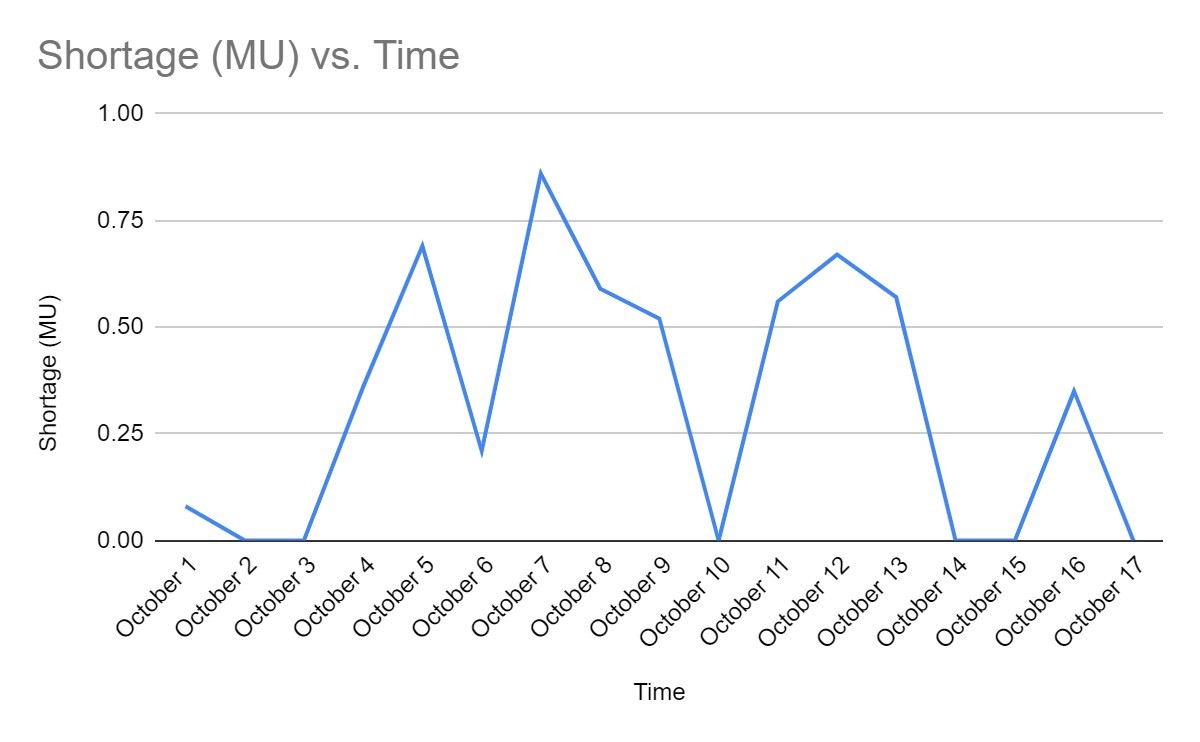
Source: Power System Operation Corporation (POSOCO)
• State energy department officials have said no power cuts will take place despite coal shortages in Tamil Nadu.
• Reports indicate that about 50% of power requirements in Tamil Nadu are met through non-conventional or renewable energy resources. Hence, wind and solar power will be used to offset the coal shortage.
• Also, no formal appeal has been made by Tamil Nadu to the centre for additional coal allocation.
NATURAL GAS PRICES
• Parts of Europe have been facing an energy crisis since mid-September due to skyrocketing natural gas prices. The crisis is expected to worsen in winter since the forecast is for a colder than average winter.
• The UK appears to be the worst affected, with at least 7 energy companies shutting operations or applying for bankruptcy in September (UK has retail tariff caps on electricity). Germany, Spain, Austria and France have also reported energy shortages.
• Fertilizer production has been impacted as a result of the crisis. In recent weeks, some firms have announced production cuts in their European units. These include Yara, Borealis and CF Industries; more are expected to follow suit.
• Some of the causes for the energy crisis in Europe are as follows:
◦ Pan-Europe gas stocks are ~25% lower than in previous years. This is mainly due to a plunge in stocks in Q1 of CY2021 due to a severe winter.
◦ Imports from Norway have reduced as the pipeline infrastructure is undergoing an overhaul.
◦ Russia (largest supplier to Europe) has fulfilled contracts, but has been unable to supply additional gas (as was expected) due to high local demand and supply bottlenecks.
◦ European companies have been outbid by East Asian companies for natural gas contracts since the first half of 2020. China doubled its gas imports over the past year due to higher industrial consumption, severe weather patterns and a shift to green energy.
◦ Drop in electricity generation from wind farms in northern Europe and a gradual shift away from coal fired power plants due to carbon taxation.
India’s dependency pattern
• India imports around half of its natural gas requirements. It is the 4th largest gas importer after Japan, China and South Korea. In 2020, Qatar accounted for over 40% of India’s imports and ~2/3rd of India’s imports came from the Middle East.
• India’s gas imports are mainly in the form of spot cargoes and short-term contracts. This strategy was adopted to avoid overdependence on a single country or region. China adopts a similar strategy; Japan and South Korea mainly rely on long-term contracts.
• Spot buying and short-term contracts increases the susceptibility of Indian gas importers to price fluctuations. See below graph of the benchmark spot rates on the Japan Korea Marker:
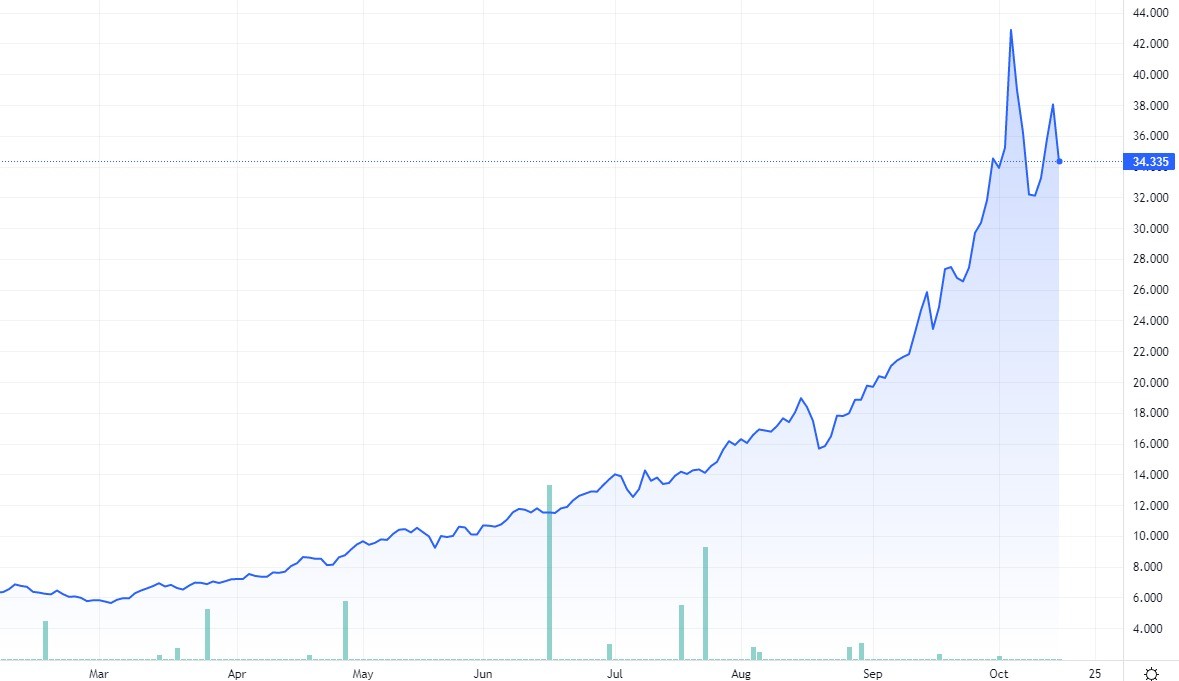
Source: Tradingview (Values in USD per MMBtu, i.e. Metric Million British Thermal Unit)
Natural gas pricing in India
• Natural gas suppliers in India have to sell at prices linked to the administered price mechanism (APM) (for domestic production) or at spot prices (for imports). See graph below for spot prices in India:
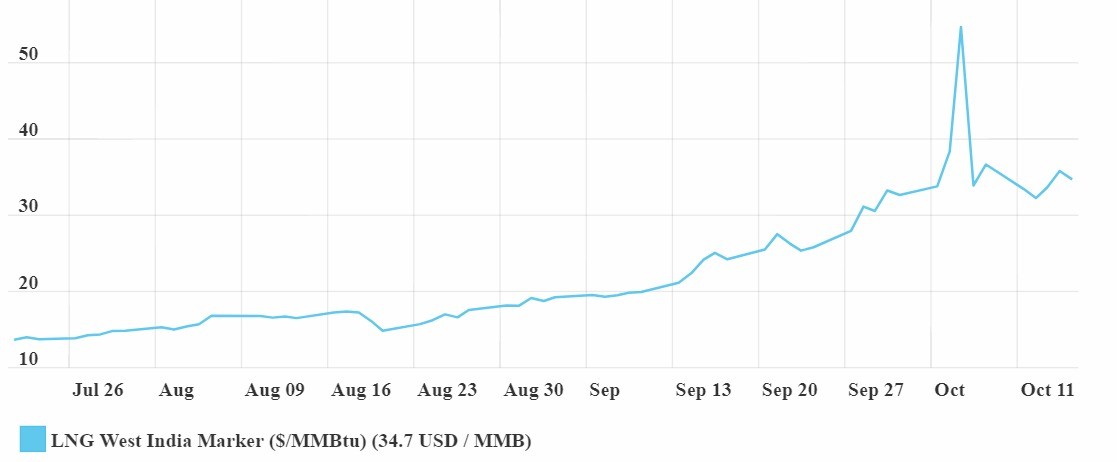
Source: S & P Global Platts
• The latest price under APM, which came into effect on October 1, was USD 2.90/mmBtu, an ~60% increase from the earlier USD 1.79/mmBtu. The APM is for 6-month periods.
• In case of gas from difficult discoveries (high pressure-high temperature, deep water and ultra-deep-water) the price was USD 6.13/mmBtu, as compared with 3.62/mmBtu before October 1. See historical data in graph below:
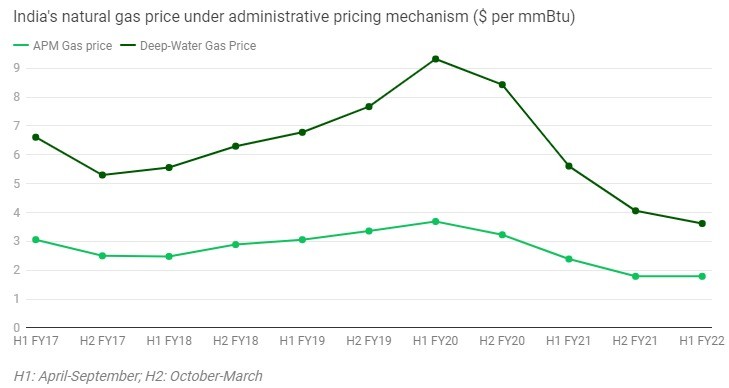
Source: Bloomberg-Quint
• APM is based on the volume-weighted annual average prices of 4 global benchmarks (US Henry Hub, Canada Alberta Gas, UK NBP and Russian Natural Gas) with a lag of one quarter.
• As a result, the current high gas rates are yet to reflect on the APM. In the April 2022 revision, the prices are expected to reach USD 5.5-7.7/mmBtu (standard) and USD 10.7/mmBtu (difficult discoveries).
• This is likely to result in high variation between APM and spot prices over the next 6 months.
• Notably, India mainly utilises domestically produced gas for energy generation. Furthermore, India’s energy generation from gas is much lower than European and North American countries at ~5-10%.
CRUDE OIL PRICES
• Crude prices have traded at their highest since October, 2018 in recent weeks. Brent crude prices have been rising steadily since late August, 2021 and by mid-October were inching towards the USD 85/barrel mark (see graph below).

Source: Trading Economics
• The rise in crude prices is attributed to a steady increase in consumption. The spike in natural gas prices has also contributed to the increase as some developing countries have been temporarily shifting to crude-based energy sources.
• However, unlike coal and natural gas shortages (which are despite full production capacity utilisation), the shortages in crude are at the discretion of OPEC+ members, who are voluntarily curtailing production.
• Earlier in October, OPEC+ rejected calls for easing production cuts despite falling inventories of member countries. OPEC+ stated that the cuts were preventing the market from experiencing wild price fluctuations. OPEC+ also trimmed its global oil demand forecast for 2021 to 5.82 million barrels per day (bpd) from 5.96 million bpd.
Meanwhile, the US reported a faster than expected inventory build-up to 6.1 million barrels in the week ending October 8. US crude production continues at a healthy rate (consistently above 10 million bpd) since weather-related disruptions in mid-September. This has led to speculation that oil prices may cool. However, analysts estimate that the US inventory build-up’s ability to correct global oil prices is limited to ~USD 3/barrel.
• Analysts have estimated that crude prices will reach USD 90/barrel by the end of CY 2021.
Indian scenario
• India imports ~85-90% of its crude requirement, which accounts for ~20% of its total import bill. Sources estimate that a USD 10/barrel increase in global crude prices can impact India’s inflation rate by ~0.3%.
• The center and states have given no indication that taxes on petrol and diesel will be relaxed amid high global crude prices. Central duties and cess account for ~42.5% of the total sales price, while state VATs range between ~15-30%. India became the highest taxed country (~70%) for fuel after a central excise hike in May, 2020.
• Retail fuel prices are at their highest ever in India. The prices in some major cities as of October 18 are as follows:
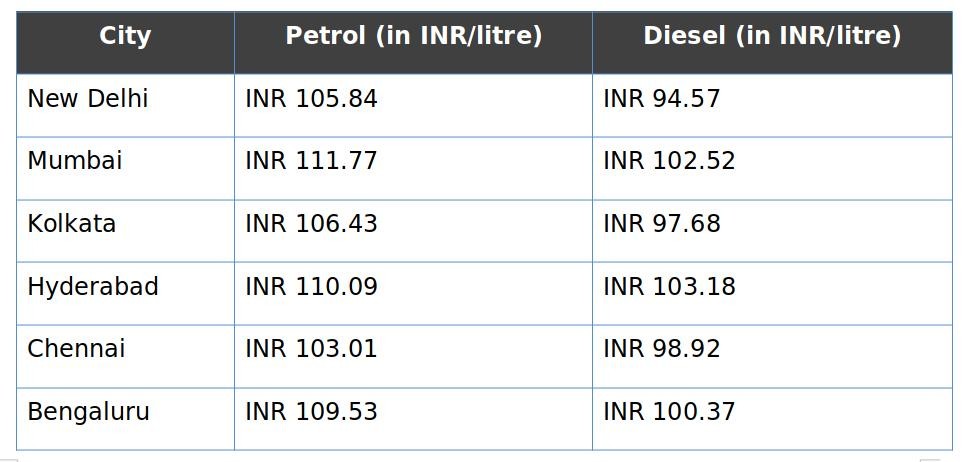


Ukrain-Forum.Biz.ua
1 year agohttps://Ukrain-Forum.Biz.ua/
1 year agohttps://odessaforum.biz.ua/
1 year agohttps://Odessaforum.BIZ.Ua/
1 year ago